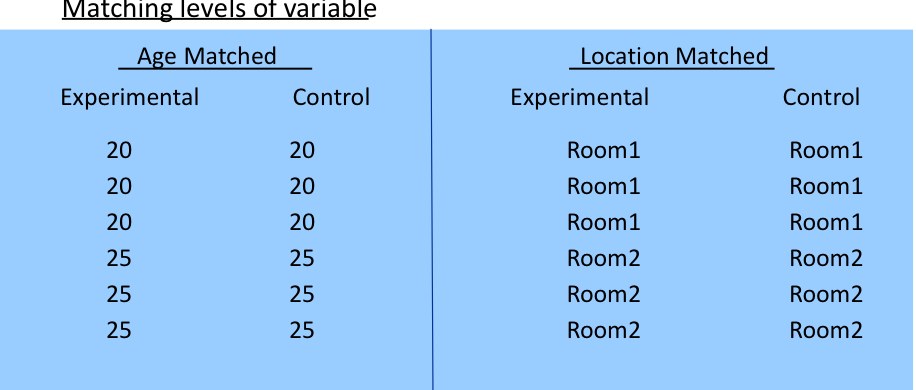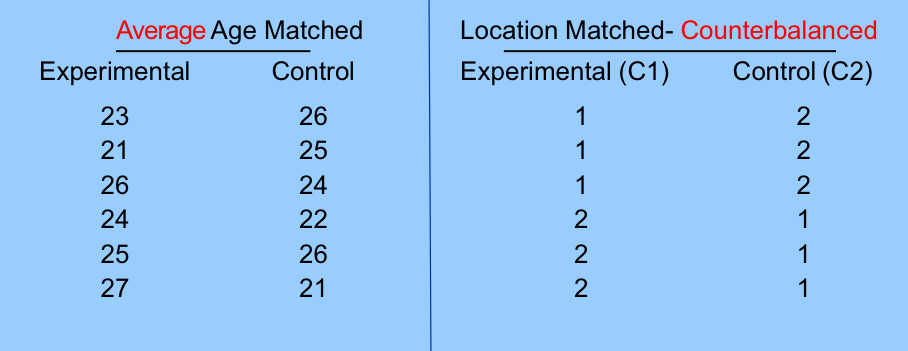Lecture 16: the experimental research strategy
1/41
There's no tags or description
Looks like no tags are added yet.
Name | Mastery | Learn | Test | Matching | Spaced |
|---|
No study sessions yet.
42 Terms
why are confounding variables threat to internal validity?
we don’t know if it’s the IV or the confounding variable that caused the change in the DV
this offer alternative explanations to your results (introduce ambiguity)
how can you avoid with confounding variables?
by examining extraneous variables for possible influence on the DV and the IV (make sure that an extraneous variable doesn’t become a confounding variable)
what are the categories of extraneous variables? (3)
environmental: different environments for each participants (lightening, hour)
participant: individual differences (age, gender, personality)
time-related: if tested over time, some things can change (history, maturation, instrumentation)
how can you control extraneous variables so that they don’t become confounding variables? (5)
remove the variable
hold the variable constant across conditions
use a placebo control
match the variable across conditions (balance or counterbalancing)
randomize the variable
*singular is used, but there could be multiple extraneous variables
true or false: we can eliminate all confounding variables
false: you can remove some confounds, but not all of them
true or false: holding a confounding variable constant works for all types of extraneous variables (environmental, participant, time-related)
false: it only works for environmental variables, but not for participant variables
how can you hold a variable constant? (2)
by standardizing the environment and procedures (works only for environment extraneous variables)
standardize the confound to a certain rage (ex: age)
what are the problems when you hold a variable constant? (2)
can become unreasonable (ex: we want 18 years old with an IQ of 110. good luck)
trade-off between standardizing variables and external validity: cannot generalize beyond the sample
when do we use a placebo control group?
when the experimental method itself can become a confounding variable
ex: you want to test a new COVID vaccine, but some people fear needle (confound). to control for this, you give the actual vaccine to the treatment group and the saline vaccine to the placebo. if there is a difference between both groups, then you know that it’s caused by the COVID vaccine and not the fear of needle
when would a placebo control group not work?
if the placebo and treatment groups are too different from each other
how can you match variables across conditions?
by balancing: match the levels across conditions
image

when do we try to balance?
when we can’t remove or hold the confounded variable constant (because counterbalance can still be complicated)
why should you try to counterbalance other factors when averages are used?
to reduce the effects due to different average values
in other words, when trying to have the same average between the experimental and control conditions, you might cause some differences that you try to solve by counterbalancing
look at recording

what’s the difference between balance and counterbalance?
balance:recording please
what are the problems of matching across conditions (balance and counterbalance? (3)
a lot of time and effort
reduced participant sample
can reduce external validity
for what set of variables should you use balancing?
those that threaten internal validity
why would you randomly assign participants to conditions?
extraneous variables related to participants will balance out across conditions
prevent the extraneous from becoming a confound: extraneous won’t be assigned to one condition
what’s an strength and weakness of randomization? (separately)
strength: powerful as it allows you to control many environmental and participant variables at the same time
weakness: it’s a chance factor, meaning that you can still get a biased outcome
what’s the difference between randomization and random assignement?
randomization: use of a random process to avoid a systematic relationship between two variables
random assignment: use of a random process to assign participants to treatment conditions
true or false: with a large group, randomization guarantees a balanced result
true: usually, it’s over 20 person
define “manipulation check”
measure to confirm that the IV has the desired effect on participants
what are the manipulation checks you can do? (2)
check the manipulation: take measures from the participant to see if the manipulation did what you wanted it to do
include an exit questionnaire that tests whether participants were aware of the manipulations and purposes of the experiment
when are manipulation checks important to do? (4)
participant manipulations: hard to know if your IV worked
subtle manipulations: hard to know if participant noticed
placebo controls: did the participant believe that the placebo real
simulations: hard to know if participant perceived the environment as real
what are the reasons why an experiment did not work? (7)
IV isn’t sensitive enough (ex: preference cookies VS chocolate… do artichoke VS chocolate)
DV isn’t sensitive enough (ex: instead of “yes/no”, use scale)
IV has a floor or ceiling effect
DV has a floor or ceiling effect
measurement error
insufficient power (not enough participants to detect the true effect of the IV)
hypothesis is wrong
what are the threats to internal validity? (8)
history: other/personal events affected the DV
maturation: normal developmental processes affected the DV
statistical regression: extreme scores on one measurement will have less extreme scores on a second measurement
selection: were the participants self-selected or assigned randomly
experimental attrition: did some participants drop out in unequal numbers across conditions
testing: did previous testing affect the behaviour at a later testing
instrumentation: dod the measurement method change
design contamination: did participants find out something about the experimental condition
define “statistical regression”, is it a threat to external or internal validity?
extreme scores on one measurement tend to be less extreme on a second measurement
internal validity: it’s not the IV that caused change to the DV
define “experimental attrition”
some participants dropping out in unequal numbers across conditions
define “design contaminaiton”
participants found out something about the experimental condition
what are the threats to external validity? (4)
unique program features: designs aspects that might be unique to your experiment (ex: overly motivated participants)
effects of selection: can this study by replicated with different participants. was the recruitment and assignment successful
effects of environment/settings: can these results be replicated in other labs/environments
effects of history: can these results be replicated in other eras/time periods
what are the experimental strategies used to strengthen external validity? (3)
lab simulations: bring “real world” in lab
mundane realism: how close the lab environment is to the real world
experimental realism: bring only the psychological aspects in the lab (mental, not visual)
define “mundane realism”
how close the lab environment is to the real world
define “experimental realism”
bring only the psychological aspects in the lab (mental, not visual)
how can you know if the original lab simulations worked? (3)
examine published simulations
it had preference for hypothetical scenarios as IV than real world (ex: let’s pretend you are in…)
it had a preference for qualitative self-reports as DV
how can you know if current-day lab simulations worked? (2)
realistic immersive stimuli (IV): put yourself in the role depending on the instructions
quantitative response measures (DV)
how can you know if high realism virtual reality (VR) worked? (2)
more positive affect when immersed in nature
similar to responses observed in actual nature (experimental realism)
define “lab simulation”
creation of conditions that simulate/duplicate the natural environment
define “field studies” and why we use them
research conducted in a place that the participant considers as natural environment
done when it’s something that is hard to measure in lab
true or false: you can do field studies with animals
true
what is the strength (for both) and weakness (both individually) for simulations and field studies?
strength:
allow researchers to test behaviour in a more realistic environment than labs
weakness
field study: hard to control for extraneous
simulation: depends on whether the participant believes if the simulation is real
what are the perils of experimental strategies? (4)
sometimes, we don’t have theories. meaning that hypotheses are ad hoc (after findings), so illogical and meaningless
some measurement instruments are not reliable or valid
sometimes use inappropriate research designs (wrong DV, no control, etc)
conditions may be incomparable or inconsistent across studies
how can you avoid the perils of experimental designs
use something that someone else already used
conduct treatment manipulation checks
conduct pilot tests with small samples to be sure that it’s the IV that caused the DV
use tasks that are simpler and familiar for the participants
when are field studies or simulations used?
as alternatives to lab experiments